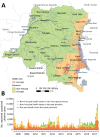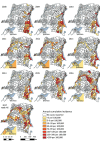Recurrent Cholera Outbreaks, Democratic Republic of the Congo, 2008-2017
- PMID: 31002075
- PMCID: PMC6478228
- DOI: 10.3201/eid2505.181141
Recurrent Cholera Outbreaks, Democratic Republic of the Congo, 2008-2017
Abstract
In 2017, the exacerbation of an ongoing countrywide cholera outbreak in the Democratic Republic of the Congo resulted in >53,000 reported cases and 1,145 deaths. To guide control measures, we analyzed the characteristics of cholera epidemiology in DRC on the basis of surveillance and cholera treatment center data for 2008-2017. The 2017 nationwide outbreak resulted from 3 distinct mechanisms: considerable increases in the number of cases in cholera-endemic areas, so-called hot spots, around the Great Lakes in eastern DRC; recurrent outbreaks progressing downstream along the Congo River; and spread along Congo River branches to areas that had been cholera-free for more than a decade. Case-fatality rates were higher in nonendemic areas and in the early phases of the outbreaks, possibly reflecting low levels of immunity and less appropriate prevention and treatment. Targeted use of oral cholera vaccine, soon after initial cases are diagnosed, could contribute to lower case-fatality rates.
Keywords: Democratic Republic of the Congo; Vibrio cholerae; bacteria; cholera; disease outbreaks; enteric infections; epidemic history; epidemiology.
Figures



References
-
- Global Task Force on Cholera Control. Ending cholera. A global roadmap to 2030. 2017 [cited 2017 Oct 9]. http://www.who.int/cholera/publications/global-roadmap.pdf?ua=1
-
- Schyns C, Fossa A, Mutombo-Nfenda, Kabuyahiya, Hennart P, Piot P, et al.. Cholera in Eastern Zaire, 1978. Ann Soc Belg Med Trop. 1979;59:391–400. - PubMed
Publication types
MeSH terms
LinkOut - more resources
Full Text Sources
Medical

